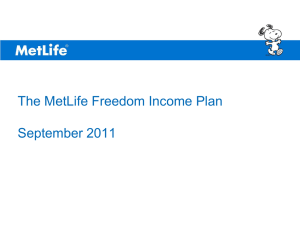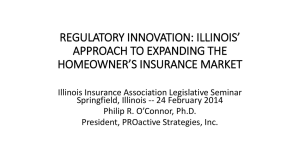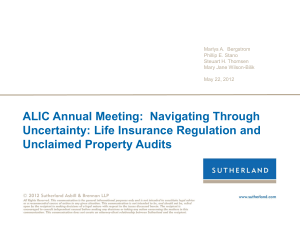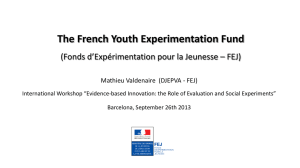the PDF and read more - Center for Insurance Research
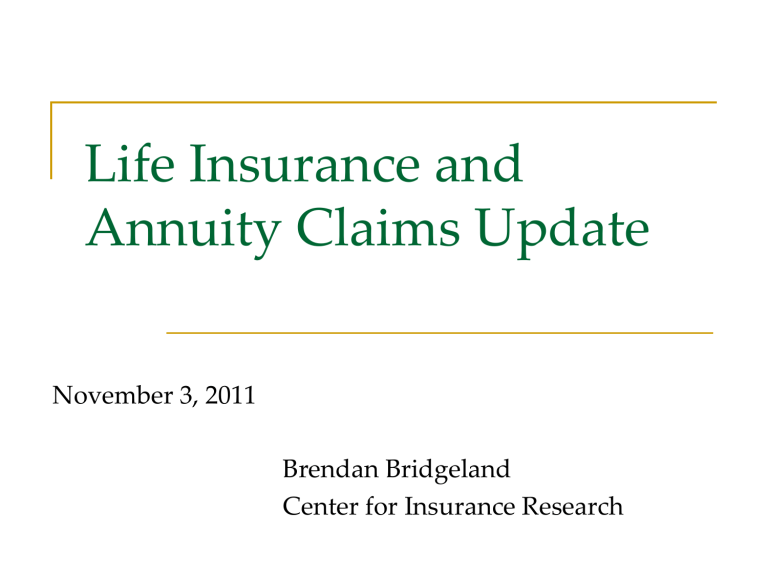
Life Insurance and
Annuity Claims Update
November 3, 2011
Brendan Bridgeland
Center for Insurance Research
Life Insurance and Annuity Claims Update
Recent Events:
Regulatory investigations have determined that a number of life insurers have been using the Social Security Death Master File (“DMF”) to identify deceased annuity policyholders in order to stop payments. The DMF was also used for “death sweeps” of COLI policies. However, even though the DMF list may be used to track deaths among annuity holders, it has not been used by insurers to determine if life insurance benefits are due to beneficiaries under individual life insurance policies.
Upon learning of this practice, a special NAIC task force was established to investigate Life Insurance Settlements Practices.
21 insurers have been audited by state officials and found to be using the DMF to identify deceased policyholders.
Regulators have estimated that more than $1 billion in benefits may have gone unclaimed. CIR believes the number is much larger.
Life Insurance and Annuity Claims Update
The John Hancock Settlements
The California Controller recently entered into a settlement with John Hancock regarding its use of the DMF and its Settlement Practices.
The Controller alleged that John Hancock had a practice of avoiding paying death benefits, instead collecting premiums from the accrued cash value of a policy when the premium payments ceased coming, depleting the cash value of the policy and avoiding the payment of a death benefit. The Controller alleged that in one case, the cash value of a life insurance policy was used to pay an individual’s premium for seven years after that person died in 1999.
Under the Settlement, John Hancock agreed to take further steps to identify deceased policy holders and notify beneficiaries. Controller John Chiang said the values of more than 6,400 California accounts would be restored and that the changes would result in more than $20 million policy benefits being distributed.
Life Insurance and Annuity Claims Update
The Florida Department of Insurance entered into a separate settlement with John
Hancock as well. As part of the Settlement, John Hancock agreed to:
Pay $3 million to the three Florida agencies that participated in the investigation and
Settlement—$600,000 of this amount was waived due to the company’s ongoing cooperation.
Return monies to beneficiaries, including interest payments owed since the date of death. If a beneficiary cannot be identified, the amount due will be reported to the
Unclaimed Property Division of the State.
Establish a $10 million fund to facilitate payment to beneficiaries that cannot be contacted.
Provide quarterly reports to the for the next three years, updating information specific to Hancock’s implementation of the agreement.
Life Insurance and Annuity Claims Update
Public Hearings: Following the announcement of the John Hancock settlements, hearings were held by regulators in Florida and California, so the public could learn more about life Insurance Settlement Practices and some of the country’s largest life insurers described how their settlement processes have incorporated the DMF:
MetLife
In 2007, MetLife ran the Social Security death index list against the majority of its individual life business and identified about $84 million in potential death claims.
Since then, MetLife has paid out about $51 million to beneficiaries.
In 2010, MetLife escheated approximately $51 million to state abandoned property funds. At the end of 2010, the total outstanding in the unclaimed fund system was approximately $325 million.
MetLife testified that most of these claims arose from older block of policies, door to door or industrial policies. These policies were last sold in 1964 and largely purchased by low-income families.
The dormancy period for these policies began as of the date the death was identified
(2007), even if the death occurred many years earlier.
Life Insurance and Annuity Claims Update
Nationwide
Nationwide started using the DMF in 2003 and 2004 – but not on individual policies until 2010. Instead, the DMF was used to identify deaths under corporate-owned life insurance, beginning in 2003.
In 2010, the Company took 1 million policies and used social security numbers to identify deaths had occurred on 5600 policies. After further research, Nationwide was left with 1,000 policies that had potential death benefits due. Since July 2010, they have found 70% of those 1,000 beneficiaries.
There were 263 leftover policies with benefits totaling $950,000 = or a $3,612 average death benefit. This once again suggests this is an issue that particularly impacts lowincome families who purchased small face value policies.
Life Insurance and Annuity Claims Update
The Benefits at Stake and Abandoned Property Limbo:
CIR believes the total amount of unclaimed benefits due to beneficiaries far exceeds
$1 billion. This is because many older policies will collect demutualization benefits in addition to the face value of a policy.
In a demutualization, mutual insurers distribute shares or cash to their participating policyholders. In recent demutualizations, a number of large life insurers revealed they had hundreds of thousands of policyholders with paid up policies that they were no longer in contact with. Unclaimed demutualization funds are often accompanied by an unpaid death benefit.
The California Controllers office has previously reported that it had received funds for 99,597 Metropolitan Life policyholders whose last known address was in
California, with a total value of more than $67 million.
Life Insurance and Annuity Claims Update
MetLife turned over 60 million unclaimed common shares to unclaimed property funds through the end of 2006.
Pennsylvania estimated that it would collect over $90 million from about 300,000 dormant demutualization accounts.
The Texas Comptroller of Public Accounts has observed that only about 30-35% of money received as unclaimed property in his state is ever claimed by its rightful owners, and that the remaining 65-70% continues to reside in general revenue where it can fund state operations.
The Delaware department of revenue, has noted the state returns less than 5% of the unclaimed property it collects.
Life Insurance and Annuity Claims Update
Locating “Lost” Policyholders and Beneficiaries
When it demutualized, John Hancock reported that it had 400,000 policyholders it could not locate. Each of these policyholders would have received a minimum of $340 in cash or stock. Subsequently, Secretaries of State in several northeastern states conducted their own searches and successfully located many of these policyholders:
Massachusetts Secretary of State William Galvin located nearly 20,000 potential addresses for policyholders who might be eligible for demutualization compensation, and identified another 14,400 who had recently died.
In Connecticut, the Secretary of State located over 6,000 “lost” policyholders of
John Hancock and 3,000 more Metropolitan Life and Prudential policyholders who were eligible for demutualization compensation.
The Vermont Secretary of State located over 600 “lost” policyholders of John
Hancock and Prudential simply by searching the records of the Vermont
Department of Motor Vehicles.
Life Insurance and Annuity Claims Update
National Conference of Insurance Legislators Activity:
NCOIL has been working on updating its Policyholder’s Bill of
Rights (originally
developed to provide standards applicable to Retained Asset Accounts). The NCOIL
Bill of Rights would:
Require use of the DMF to identify deaths on individual life insurance policies on an annual basis at least;
Prohibit the use of a database for annuity purposes unless it is also use to search for potential death claims;
Requires the company to confirm or verify the status of an insured one a potential match is made; and
Provide that the abandoned property dormancy period begins running once the match is first made.
Life Insurance and Annuity Claims Update
Conclusions
Using of the DMF, or any similar databases, for one purpose (that protects the interests of insurers), but not to scan for benefits due on individual life insurance policies is an unbalanced approach. Technological developments should be used to assist individual life insurance beneficiaries as well as insurers.
Using the DMF to provide payouts on COLI policies, to benefit corporate investors, but not for individual policyholders is particularly troubling.
Given that a large portion of funds that escheat to state abandoned property funds go unclaimed, insurance regulators can benefit life insurance consumers the most by developing standards that require death benefits to be identified and distributed in a timely fashion.
Life Insurance and Annuity Claims Update
CIR Recommendations:
Annual Statements Blanks should be amended to require reporting total abandoned property transfers made each year, by jurisdiction and policy type so adequate data are available to evaluate the abandoned property system as a whole. This should be added to the State Pages of the Annual Statement.
A summary of state abandoned property laws should be added to the NAIC’s
Compendium of State Laws on Insurance Topics.
Standards should be established for beneficiary searches conducted by insurers.
More thorough searching is necessary and practical, as the efforts undertaken by various Secretaries of States has shown.
Regulators should consider the development of recommended changes to abandoned property laws to better account for the unique nature of insurance products, such as adjusting the limiting age.
All states should be encouraged to participate in the National Association of
Unclaimed Property Administrators database system in order to permit national searches for unclaimed property.

